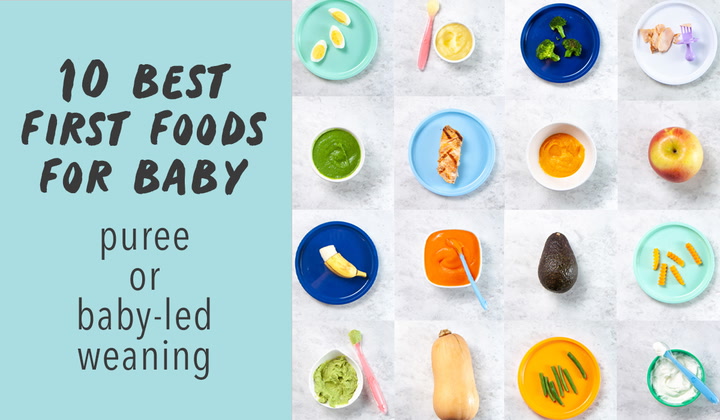What are the best baby foods to start with
Do's and Don'ts for Baby's First Foods
Breastfeeding has been shown to improve infant, child and maternal health outcomes and help control healthcare costs, but how long should breastfeeding last and when should parents introduce solid foods?
The Dietary Guidelines for Americans recommend exclusive breastfeeding, meaning the infant receives only breast milk, during the first six months of life for optimal nutrition and health benefits.
Once solid foods are introduced, health professionals recommend continuing breastfeeding through 12 months of age and, after that, as desired by mother and baby. Introducing your baby to solid foods is an exciting milestone. When you start introducing children to the world of solid foods, you are helping them shape their relationship with food and establish a healthy eating style. The timing for introducing solid foods will depend on the infant, but it is not recommended before the age of four months or after the age of six months.
Not sure how to get your baby started on solid foods? Consider these helpful tips.
Is Your Baby Ready to Transition?
Each child's readiness for solid food depends on their own rate of development. Signs a baby may be ready to start solid foods include sitting up with minimal support, demonstrating good head control, bringing objects to the mouth or grasping at small objects. Check with your pediatrician before starting solid foods.
Getting Started With Solids
Solid foods may be introduced in any order. However, puréed meats, poultry, beans and iron-fortified cereals are recommended as first foods, especially if your baby has been primarily breastfed, since they provide key nutrients. Only one new single-ingredient food should be introduced at a time.
Softer textures are very important when first introducing foods. Infants usually start with pureed or mashed foods around six months. As infants develop chewing and motor skills, they are able to handle items like soft pieces of fruit and finger foods. As the child ages, a variety of healthful foods is encouraged.
As the child ages, a variety of healthful foods is encouraged.
Weaning From Breastfeeding
When deciding if you should wean your baby to a bottle or a cup, consider their developmental readiness. Between 7 and 8 months, most infants will drink small amounts of liquid from a cup or a glass when someone else holds it. Older babies and toddlers often have the coordination to drink fluids from a cup by themselves.
If your baby is under 12 months of age and you are not continuing to breastfeed, wean from breast milk to iron-fortified infant formula. If your baby is 12 months or older, whole cow’s milk is appropriate.
Food Safety Do’s and Don’ts
Food safety concerns for infants and toddlers include food allergies, choking and risks for foodborne illness. Keep the following safety tips in mind:
Do talk with your pediatrician about the risk of food allergies. Introducing one new food at a time, every several days, allows time to monitor for allergic reactions.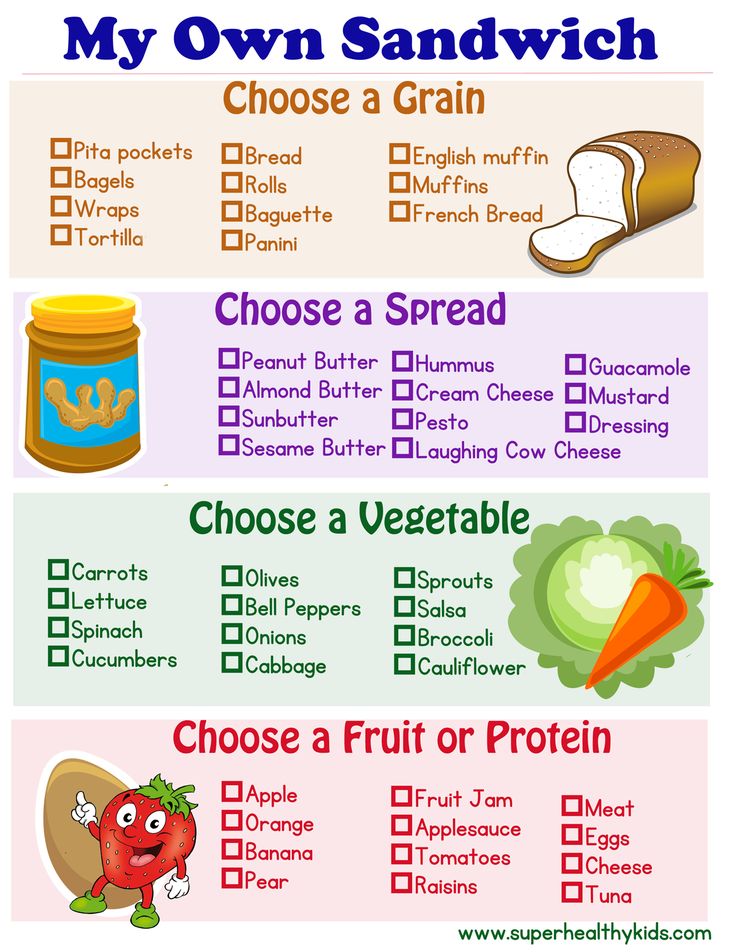 Current evidence does not indicate needing to wait beyond 4 to 6 months before introducing potential allergy-causing foods such as eggs, dairy, soy, peanuts and fish. In fact, introducing peanut-containing foods as early as 4 to 6 months of age may help prevent a peanut allergy. The Dietary Guidelines for Americans recommends introducing potentially allergenic foods when other complementary foods are introduced to an infant’s diet. Parents with concerns about food allergies should discuss how to include these foods with their pediatrician.
Current evidence does not indicate needing to wait beyond 4 to 6 months before introducing potential allergy-causing foods such as eggs, dairy, soy, peanuts and fish. In fact, introducing peanut-containing foods as early as 4 to 6 months of age may help prevent a peanut allergy. The Dietary Guidelines for Americans recommends introducing potentially allergenic foods when other complementary foods are introduced to an infant’s diet. Parents with concerns about food allergies should discuss how to include these foods with their pediatrician.
Don’t feed your baby solid foods from a bottle. It can be a choking hazard and despite a popular misconception, putting cereal in a baby's bottle won't help with sleeping through the night. Other foods that are considered to be choking hazards are listed below.
Do supervise your child while eating. Infants should be able to sit upright and face forward when you first introduce solid foods. This makes swallowing easier and choking less likely.
Don’t feed directly from the jar of food but instead spoon some food into a separate dish first. Feeding directly from the jar may introduce bacteria from your baby's mouth to the spoon and back into the food, creating a food safety issue.
Don’t feed honey to children under 12 months of age due to the risk of foodborne illness.
Examples of appropriate solid foods listed by age:
6 months:
- Well-cooked and pureed meat, poultry or beans
- Ground, cooked, single-grain cereal or infant cereal with breast milk or formula
- Cooked and pureed vegetables
- Mashed banana or avocado
9 months:
- Well-cooked, minced or finely chopped meat, poultry or beans
- A variety of cooked vegetables cut into small, ½ inch pieces, such as squash and green beans
- Sliced and quartered bananas or small pieces of other soft fruits
12 months:
- Soft, shredded meat, poultry or fish
- Small pieces of cooked vegetables
- Small pieces of soft, easy to chew fruits
- Mixed food dishes the family is eating in appropriately sized pieces
Not recommended for those under 4 years of age due to the risk of choking:
- Popcorn and whole kernel corn
- Nuts and seeds
- Large chunks of meat, poultry and cheese
- Candy, gum drops and jelly beans
- Hard, raw fruits or vegetables such as apples, celery and carrots
- Whole grapes and cherry tomatoes, unless cut into quarters
- Hot dogs, unless cut into strips and age appropriate, bite-size pieces
- Sticky foods, such as peanut butter, which can get stuck in the back of the mouth – peanut butter is okay if spread thinly on bread
For toddlers and preschoolers, chop grapes, meat, poultry, hot dogs and raw vegetables and fruits into small pieces (about ½ inch or smaller).
Nurturing Healthy Relationships with Food
Establishing a positive feeding relationship during infancy can have lifetime benefits. Keep in mind that children are responsible for how much and whether they eat so always wait for your baby to pay attention to each spoonful before you feed them. Don't be afraid to let your baby touch the food in the dish and on the spoon. You wouldn't want to eat something if you didn't know anything about it, would you? In addition, know the cues that your baby is done eating. A common cue babies are full is head turning.
Whatever happens, don't get discouraged and enjoy the experience. With a little patience and creativity, you can make your baby's first solid food eating experience fun for everyone involved!
Tags
Find a Nutrition Expert
Looking for credible nutrition information and recommendations? The Academy of Nutrition and Dietetics' network of credentialed food and nutrition practitioners are ready to help!
See Directory
The Best First Foods for Babies 6 to 9 Months – Happiest Baby
By Happiest Baby Staff
On This Page
- Best Baby Foods at 6 Months
- Best Baby Foods at 7 Months
- Best Baby Foods at 8 Months
- Best Baby Foods at 9 Months
You've spent the first six months of your baby's life making sure that they are nourished with breastmilk or formula. As they grow and thrive, you might notice that your little sprout shows you some signs that they are ready to graduate from the bottle or breast to solid foods. If your baby can sit up and hold their head up, that's a great first sign! What's more, if they bring objects to their mouth and show an interest in what you are eating, your curious kiddo might be ready to start eating solid foods.
As they grow and thrive, you might notice that your little sprout shows you some signs that they are ready to graduate from the bottle or breast to solid foods. If your baby can sit up and hold their head up, that's a great first sign! What's more, if they bring objects to their mouth and show an interest in what you are eating, your curious kiddo might be ready to start eating solid foods.
But what should you feed your baby? Here’s a list of perfect starter foods for your baby from ages 6 to 9 months.
Best Baby Foods at 6 MonthsAt 6 months, babies may be starting to chew. Though this skill won’t be mastered just yet, they are typically ready to get messy with some mushy, pureed eats—helping them learn about flavor and texture. At this age, the goal is not to satiate your baby with full meals of solid foods but rather to get your child curious and excited about their culinary options.
Because babies are growing so fast, their needs for iron are high to prevent iron-deficiency and support their overall health. Offer your little one iron rich foods like—infant cereal (read up on why you may want to skip rice cereal), well-cooked meat, poultry, mashed beans, and lentils. To keep your baby safe from choking, avoid adding solids like cereal to baby bottles.
Offer your little one iron rich foods like—infant cereal (read up on why you may want to skip rice cereal), well-cooked meat, poultry, mashed beans, and lentils. To keep your baby safe from choking, avoid adding solids like cereal to baby bottles.
Here are some great first foods for Baby to try:
- Infant oat, grain, or barley cereals mixed with breastmilk or formula and spoon-fed to your baby
- Sweet potato puree
- Squash puree
- Pea puree
- Carrot puree
- Mashed banana
- Mashed avocado
- Mashed or pureed beans
- Mashed or pureed lentils
- Pureed meats (beef, chicken, or turkey)
- Soft, falling apart meats (salmon, beef, chicken, turkey)
Check out more of our favorite first food purees. Or, if purees aren’t your thing, read up on how to start baby-led weaning.
Best Baby Foods at 7 MonthsBy 7 months old, your baby will probably be eating more solids but not enough to replace breastmilk or formula as their primary source of food.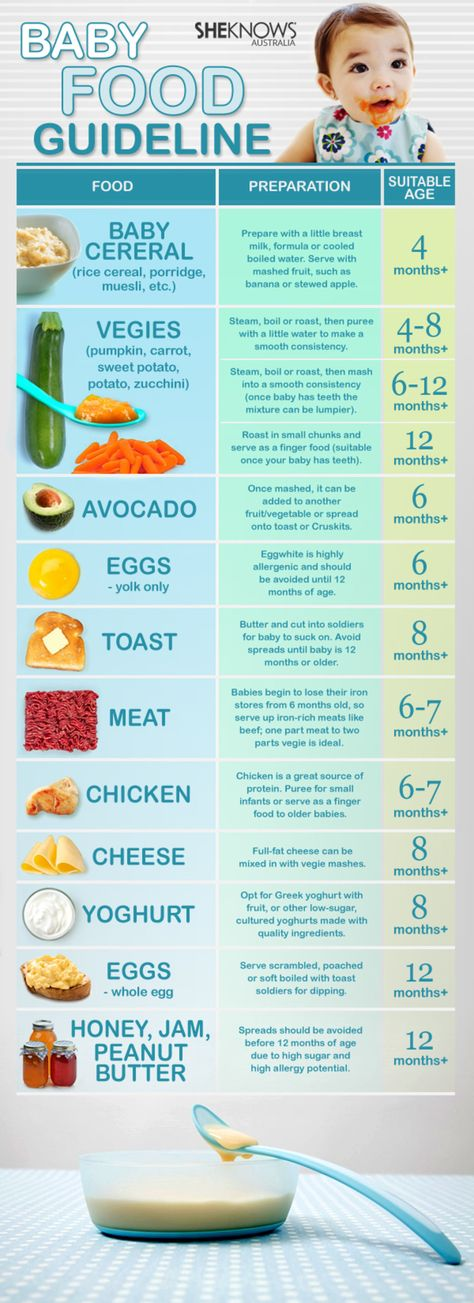 The goal for this month is to keep introducing solid foods to your baby. What's fun is by 7 months, you can get more creative with mixing flavors and adding textures.
The goal for this month is to keep introducing solid foods to your baby. What's fun is by 7 months, you can get more creative with mixing flavors and adding textures.
Here are a few nutritious and delicious food combos to try with your baby:
- Peas pureed with breastmilk (or formula), sweet potatoes, or squash
- Kale pureed with blueberry, squash, potatoes, sweet potatoes, peas, pears, or bananas
- Apples pureed with cauliflower, carrots, pears, prunes, or beets
- Beef pureed with broccoli
- Chicken pureed with carrots and potatoes
- Chickpeas pureed with bananas, apples, or sweet potato
- Sweet potatoes pureed with red bell pepper
Seven months is also the perfect age to start giving your baby a plate, bowl, and plastic utensils so they can begin to practice feeding themselves. If your baby is teething, you can place frozen chunks of fruit in a sieve feeder/mesh bag that allows them to gnaw on the fruit without choking. Learn more about helping your baby use a fork and spoon!
Learn more about helping your baby use a fork and spoon!
By 8 months, your baby is likely eating more solids and relying a little less on milk as a primary meal (though it’s still where they get the bulk of their nutrition!). And they’re probably having lots of fun learning how to use their hands to feed themselves. Something else to consider: Babies should be exposed to potential allergen foods (like peanuts, tree nuts, eggs, and fish) before their first birthdays to help prevent future food allergies. Starting at 6 months of age, peanut butter is safe to introduce as long as you are comfortable giving it to your baby.
In fact, the Dietary Guidelines for Americans says that babies can begin having these foods when they start eating solids. But many families often feel more comfortable waiting to introduce these foods until around this age. Of course, consult with your little one’s pediatrician if you have concerns about potential allergen foods.
Here are some foods to add to your repertoire:
- Whole eggs, scrambled
- Nut butter thinned out with water and mixed with cereal (nut butters are sticky and can cause choking)
- Fully cooked fish, like salmon or tuna
- Full-fat yogurt
Here are some preparation ideas:
- Well-cooked (think over-cooked until falling apart) pasta such as elbows or alphabet shapes
- Mashed meat with mashed or ground vegetables such as peas and potatoes or kale and squash
- Rainbow on a plate: Using tiny pieces of soft, strained, pureed, and mashed food options, look for a variety of colors to offer. Some fun options could include banana, avocado, sweet potato, peas, blueberry, raspberry, cheese, and chicken.
Though there’s a greater variety of foods babies eat now, formula or breastmilk continues to be their primary source of nutrition until age 1. At 9 months old, babies get more comfortable with self-feeding and eating the foods their families enjoy. After all, eating solid foods is a sensory wonderland of texture, smells, and tastes. Not to mention all that fun making messes with those adorably curious fingers.
After all, eating solid foods is a sensory wonderland of texture, smells, and tastes. Not to mention all that fun making messes with those adorably curious fingers.
As you begin to focus on meal planning for your baby, there are few things to keep in mind:
- Babies need four to five servings of fruits and vegetables a day. A serving size for a 9-month-old is less than a quarter cup.
- "Eat the rainbow" is excellent advice because it gives your baby exposure to lots of different fruits, vegetables, grains, and starches.
Here are a few menu ideas to help meal plan for your baby…
Breakfast Ideas for Babies
These morning meals pack a nutritional punch—and don’t forget to check out all of our favorite breakfast ideas for babies:
- Soft fresh fruit cut up in small pieces (think: banana, raspberries, or blueberries)
- Whole-grain waffles or pancakes
- Unsweetened oatmeal made with breastmilk or formula combined with cut-up and cooked apples and pears or banana slices.
 (It is essential to steam the apples or pears to make them soft enough for your baby to mash with their gums.)
(It is essential to steam the apples or pears to make them soft enough for your baby to mash with their gums.) - Full-fat yogurt mixed with mashed or pureed berries such as blueberries, blackberries, strawberries, or raspberries
- Soft scrambled eggs
- Veggie frittata
Lunch Ideas for Babies
- Spread hummus on soft crackers or bread
- Grilled cheese sandwich with cooled tomato soup
- Macaroni and cheese with cooked veggies like peas and carrots mixed in
- Pizza bites with chopped bits of spinach in the sauce and melted shredded cheese
- Quesadilla made with pureed spinach, squash, or beans
Snack Ideas for Babies
Babies this young won’t likely need to snack too much (remember, breastmilk or formula will provide the majority of your little one’s nutrition). Still, it’s not a bad idea to have snacks on hand for when your mini muncher needs something to eat that’s not quite a meal. A few baby snack ideas:
- Apple and carrot slaw
- Cheese slices
- Full-fat plain yogurt
- Hard-boiled egg
- Avocado slices
- Muffins made with fruits, veggies, and/or whole grains
- Fruit and veggie pouches
- Sugar-free, whole-grain cereal, like plain Cheerios
Dinner Ideas for Babies
To help your baby get and stay excited about eating solid foods, serve a version of whatever the family is having for dinner. Remember to steam or mash, grind or chop foods into appropriate softness and sizes to prevent choking. Some baby dinner ideas:
Remember to steam or mash, grind or chop foods into appropriate softness and sizes to prevent choking. Some baby dinner ideas:
- Pasta with softened vegetables
- Well-cooked rice, soft veggies, and chicken
- Baked sweet potato with butter or cheese
- Beans or lentils served with rice and veggies
- Flaky fish served with steamed zucchini
There are endless variations on what you can serve your baby for dinner. As long as your baby is safe and happy, try to encourage lots of food exploration!
You must not feed any child under the age of 1 year honey, cow’s milk, juice, hard foods like candy, raw vegetables, popcorn, or sticky foods like peanut butter, as these each present choking hazards.
Learn more about feeding your baby:
- The Happiest Baby Feeding Guide
- The Benefits of Homemade Baby Food
- The Best Store-Bought Baby Food
***
REFERENCES
- Unlocking Opportunities in Food Design for Infants, Children, and the Elderly: Understanding Milestones in Chewing and Swallowing Across the Lifespan for New Innovations.
 Journal of Texture Studies, August 2017
Journal of Texture Studies, August 2017 - Complementary Feeding: A Position Paper by the European Society for Paediatric Gastroenterology, Hepatology, and Nutrition (ESPGHAN) Committee on Nutrition, Journal of Pediatric Gastroenterology and Nutrition, January 2017
- Infant Formula Feeding Practices Associated With Rapid Weight Gain: A Systematic Review, Maternal & Child Nutrition, July 2018
- Solid Food Introduction and the Development of Food Allergies, Nutrients, November 2018
- US Department of Agriculture: Dietary Guidelines for Americans 2020-2025
View more posts tagged, feeding
Have questions about a Happiest Baby product? Our consultants would be happy to help! Connect with us at [email protected].
Disclaimer: The information on our site is NOT medical advice for any specific person or condition.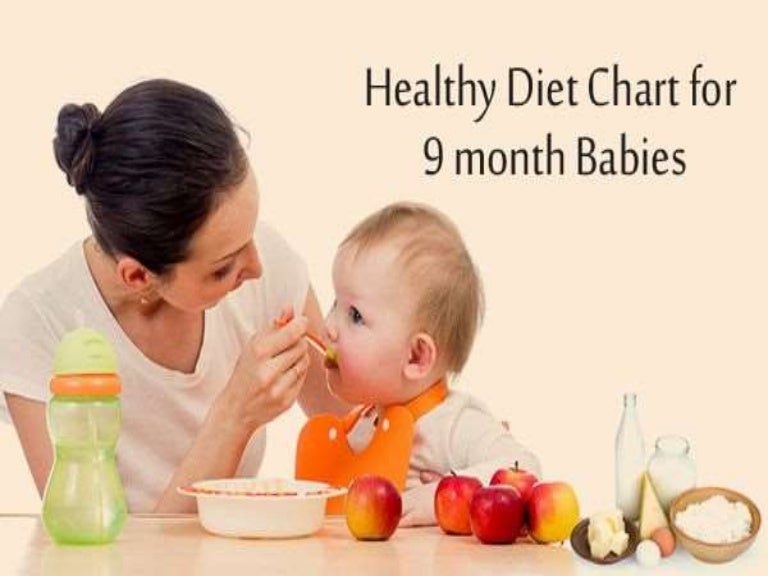 It is only meant as general information. If you have any medical questions and concerns about your child or yourself, please contact your health provider.
It is only meant as general information. If you have any medical questions and concerns about your child or yourself, please contact your health provider.
when and how to start the first feeding of a child?
Complementary feeding is the gradual transition of an infant from mother's milk or formula to more solid foods. Despite its naturalness, this process has some nuances. We will tell you when and where to start complementary foods so that this stage is as comfortable as possible for the baby.
Children develop in different ways: some are faster and some are slower. Therefore, at the beginning of complementary feeding of an infant, first of all, it is worth focusing not on his age, but on the presence of a number of skills. First of all, there should be food interest: the child usually “announces” this himself, starting to put his hands in his mouth, showing a desire to try food from his mother’s plate. It is also important that the baby confidently holds his head and sits, albeit with support, on the parent's lap or in a special chair. Of course, you need to make a decision about the start of complementary foods together with your doctor.
Of course, you need to make a decision about the start of complementary foods together with your doctor.
When to start complementary foods? The "golden window" is an interval of four to six months. If you believe the statistics, most often the start of complementary foods for a baby falls on the age of five to six months. We emphasize once again that everything is individual, but it is also not recommended to delay the introduction of complementary foods too much. Starting complementary foods after seven months is fraught with a delay in the development of habits for eating thicker and denser foods, and then chewing skills. In addition, late feeding can negatively affect the formation of taste sensations and lead to a lack of a number of substances in the body: iron, zinc, calcium, copper, vitamin D and others. If closer to seven months the child does not have the skills necessary to start the first complementary foods, this must be reported to the pediatrician.
Where to start complementary foods
Of course, not all foods are suitable for this. You need to move on to solid food gradually, and milk porridges (especially buckwheat, rice and corn) and vegetable purees are optimal as a “link”. This is stated in the National program for optimizing the feeding of children in the first year of life in the Russian Federation, approved by the Union of Pediatricians of Russia (hereinafter referred to as the National Program) [1].
You need to move on to solid food gradually, and milk porridges (especially buckwheat, rice and corn) and vegetable purees are optimal as a “link”. This is stated in the National program for optimizing the feeding of children in the first year of life in the Russian Federation, approved by the Union of Pediatricians of Russia (hereinafter referred to as the National Program) [1].
It is important to remember that the first complementary foods should be monocomponent, that is, contain only one product. Conventionally: mashed potatoes to start complementary foods can be squash or potato, but not a mix of these vegetables. By the way, babies with allergies are recommended mashed white or green vegetables. Complementary foods are better to start with microdoses, literally from a quarter of a teaspoon. Every day the volume should be increased. For convenience, you can keep a food diary and note all the dynamics in it.
The National Program recommends starting complementary foods with vegetables or cereals. Usually cereals are administered first if the child is underweight. After the baby is a little accustomed to porridge, you can add vegetables to his diet. If complementary foods begin with vegetables, the next, respectively, will be porridge. After two or three weeks, you can try giving your baby fruit puree made from apples, pears, or peaches. Later, you can add berry purees to the diet.
Usually cereals are administered first if the child is underweight. After the baby is a little accustomed to porridge, you can add vegetables to his diet. If complementary foods begin with vegetables, the next, respectively, will be porridge. After two or three weeks, you can try giving your baby fruit puree made from apples, pears, or peaches. Later, you can add berry purees to the diet.
After the baby has become accustomed to mono-component complementary foods, two-component complementary foods can be introduced. For example, it can be porridge with fruit or vegetable puree. An important nuance: both components must first be “tested” separately to make sure that the child tolerates them well. You can not immediately feed the baby rice porridge with broccoli: first he needs to try rice, and the next time - broccoli. There is no need to draw hasty conclusions: for each new type of complementary foods, doctors advise taking five to ten days.
The next stage is the transition to semi-solid food. Of course, not all products are suitable here either. Cream soup, chopped pieces of boiled vegetables, meat and fish will be optimal. By the way, about meat - it should also be added carefully to the baby's diet, starting with monocomponent meat purees. At first, it is recommended to feed the baby with mashed rabbit and turkey and only then switch to beef, veal and chicken. It's the same with juices: we start with a clarified mono-fruit, apple or pear drink, and then you can expand the menu to carrot, pumpkin, plum, apricot and peach. It is worth remembering that the last three have a slight laxative effect. Closer to the year, you can try to give the child solid food - for example, small meatballs or the same cereals, only with unground cereals [2].
Of course, not all products are suitable here either. Cream soup, chopped pieces of boiled vegetables, meat and fish will be optimal. By the way, about meat - it should also be added carefully to the baby's diet, starting with monocomponent meat purees. At first, it is recommended to feed the baby with mashed rabbit and turkey and only then switch to beef, veal and chicken. It's the same with juices: we start with a clarified mono-fruit, apple or pear drink, and then you can expand the menu to carrot, pumpkin, plum, apricot and peach. It is worth remembering that the last three have a slight laxative effect. Closer to the year, you can try to give the child solid food - for example, small meatballs or the same cereals, only with unground cereals [2].
An equally important product in the complementary food menu is cottage cheese. Natural curds contain calcium and phosphorus, which positively affect the functioning of the heart. In addition, the calcium contained in the cottage cheese strengthens the bones and teeth of the baby, which is very important at a “tender” age. The composition of cottage cheese also includes albumin, a protein that produces antibodies that positively affect the development of the nervous system. In addition, the use of cottage cheese helps to normalize the work of the digestive tract and liver. Experts advise introducing curd complementary foods after vegetable puree and canned meat. It is worth starting with a small dose - half a teaspoon - once a day. It is important to remember that cottage cheese is allowed in the diet of babies only from six to eight months. It is not recommended to give such a product before, because the protein contained in it puts a strain on the kidneys.
The composition of cottage cheese also includes albumin, a protein that produces antibodies that positively affect the development of the nervous system. In addition, the use of cottage cheese helps to normalize the work of the digestive tract and liver. Experts advise introducing curd complementary foods after vegetable puree and canned meat. It is worth starting with a small dose - half a teaspoon - once a day. It is important to remember that cottage cheese is allowed in the diet of babies only from six to eight months. It is not recommended to give such a product before, because the protein contained in it puts a strain on the kidneys.
A few tips for mothers: how to introduce complementary foods without stress for the baby
If the baby does not like the product, do not categorically refuse it. It is better to remove it for four to eight weeks and then try to introduce it into the diet again, a little bit, like the first time. It is likely that the second experience will be successful: the main thing is to carefully monitor the reaction of the baby's body.
Many young mothers are also faced with a choice: cook it yourself or buy canned food? Making your own meals for your baby is usually cheaper, but it can be quite a hassle. First, you need to carefully choose the ingredients: store-bought vegetables can contain nitrates. Secondly, it is better not to cook with a margin: it is difficult to maintain sterility in the home kitchen, so it is undesirable to store baby food. It is best to cook before eating so that the food is fresh. When buying mashed potatoes in the store, you should pay attention to the expiration date and compliance with storage conditions [3].
As for cereals to start feeding a child, they can be divided into dairy-free (recommended for children with lactase deficiency and allergies) and dairy. The latter, in turn, are based on an adapted milk formula, goat's or cow's milk. Compared to cow's, goat's milk is closer to human breast milk in terms of protein and fat composition.
What's more, it contains a high dose of A2-protein (β-casein), which is easy to digest and improves the intestinal microflora. But the complex protein α-s1-casein, which is found in cow's milk, is practically absent in goat's milk. That is why goat milk baby food is digested five to six times faster. Another important feature of it is small evenly distributed fat globules. They are rich in medium chain triglycerides, which are quickly absorbed in the intestines and provide the baby with energy [4].
But the complex protein α-s1-casein, which is found in cow's milk, is practically absent in goat's milk. That is why goat milk baby food is digested five to six times faster. Another important feature of it is small evenly distributed fat globules. They are rich in medium chain triglycerides, which are quickly absorbed in the intestines and provide the baby with energy [4].
In order for the baby to easily switch to “adult food”, it is very important to start complementary foods correctly. How to start depends on the individual characteristics of the baby's body. It is important for mothers to know that industrial complementary foods are safe and contain all the necessary components for the normal development of the baby. The introduction of complementary foods is clearly not a question where you need to listen to the advice of friends and relatives. Even if they sincerely wish the baby health and want "the best". This area has been studied by more than one generation of pediatricians, so it is better to trust the recommendations of professional doctors.
Diet for a 4-6 month old baby
Your baby is already 4 months old. He has noticeably grown up, become more active, is interested in objects that fall into his field of vision, carefully examines and reaches for them. The emotional reactions of the child have become much richer: he joyfully smiles at all the people whom he often sees more and more often, makes various sounds.
You are still breastfeeding your baby or have had to switch to mixed or artificial feeding. The child is actively growing, and only with breast milk or infant formula, he can no longer always get all the necessary nutrients. And that means it's time to think about complementary foods.
The optimal time to start its introduction is between 4 and 6 months, regardless of whether the baby is receiving breast milk or formula. This is the time when children respond best to new foods. Up to 4 months, the child is not yet ready to perceive and digest any other food. And with the late introduction of complementary foods - after 6 months, children already have significant deficiencies of individual nutrients and, first of all, micronutrients (minerals, vitamins, long-chain polyunsaturated fatty acids, etc. ). In addition, toddlers at this age often refuse new foods, they have delayed development of chewing skills for thick foods, and inadequate eating habits are formed. It is important to know that, no matter how strange it may seem at first glance, with a delayed appointment of complementary foods, allergic reactions more often occur on them.
). In addition, toddlers at this age often refuse new foods, they have delayed development of chewing skills for thick foods, and inadequate eating habits are formed. It is important to know that, no matter how strange it may seem at first glance, with a delayed appointment of complementary foods, allergic reactions more often occur on them.
When is it advisable to introduce complementary foods as early as 4 months, and when can we wait until 5.5 or even 6 months? To resolve this issue, be sure to consult a pediatrician.
As a rule, at an earlier age (4 - 4.5 months), complementary foods are introduced to children at risk of developing iron deficiency anemia, as well as children with insufficient weight gain and with functional digestive disorders.
The optimal time to start introducing complementary foods to a healthy baby is between 5 and 5.5 months of age.
The World Health Organization recommends that breastfed babies should be introduced to complementary foods from 6 months of age.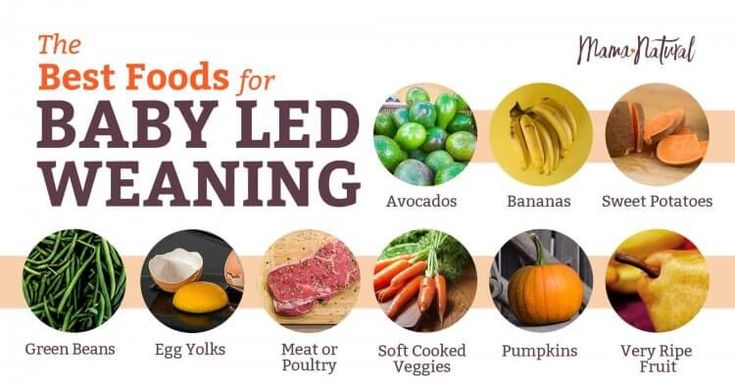 From the point of view of domestic pediatricians, which is based on extensive practical experience and scientific research, this is possible only in cases where the child was born on time, without malnutrition (since in these cases the mineral reserves are very small), he is healthy, grows well and develops. In addition, the mother should also be healthy, eat well and use either specialized enriched foods for pregnant and lactating women, or vitamin and mineral complexes in courses. Such restrictions are associated with the depletion of iron stores even in a completely healthy child by 5-5.5 months of age and a significant increase in the risk of anemia in the absence of complementary foods rich or fortified with iron. There are other deficits as well.
From the point of view of domestic pediatricians, which is based on extensive practical experience and scientific research, this is possible only in cases where the child was born on time, without malnutrition (since in these cases the mineral reserves are very small), he is healthy, grows well and develops. In addition, the mother should also be healthy, eat well and use either specialized enriched foods for pregnant and lactating women, or vitamin and mineral complexes in courses. Such restrictions are associated with the depletion of iron stores even in a completely healthy child by 5-5.5 months of age and a significant increase in the risk of anemia in the absence of complementary foods rich or fortified with iron. There are other deficits as well.
The first complementary foods can be vegetable puree or porridge, it is better to give fruit puree to the baby later - after tasty sweet fruits, children usually eat vegetable puree and cereals worse, often refuse them altogether.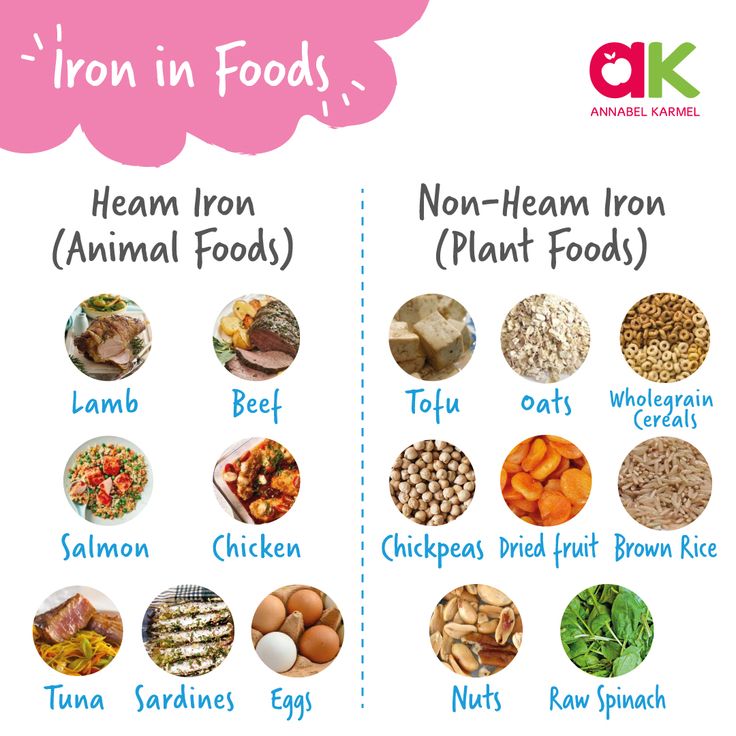
Where is the best place to start? In cases where the child has a tendency to constipation or he puts on weight too quickly, preference should be given to vegetables. With a high probability of developing anemia, unstable stools and small weight gains - from baby cereals enriched with micronutrients. And if you started introducing complementary foods with cereals, then the second product will be vegetables and vice versa.
If the first complementary foods are introduced at 6 months, it must be baby porridge enriched with iron and other minerals and vitamins, the intake of which with breast milk is no longer enough.
Another important complementary food product is mashed meat. It contains iron, which is easily absorbed. And adding meat to vegetables improves the absorption of iron from them. It is advisable to introduce meat puree to a child at the age of 6 months. Only the daily use of children's enriched porridge and meat puree can satisfy the needs of babies in iron, zinc and other micronutrients.
But it is better to introduce juices later, when the child already receives the main complementary foods - vegetables, cereals, meat and fruits. After all, complementary foods are needed so that the baby receives all the substances necessary for growth and development, and there are very few in their juices, including vitamins and minerals.
Juices should not be given between feedings, but after the child has eaten porridge or vegetables with meat puree, as well as for an afternoon snack. The habit of drinking juice between meals leads to frequent snacking in the future, a love of sweets is instilled, children have more tooth decay and an increased risk of obesity.
With the start of the introduction of complementary foods, the child is gradually transferred to a 5-time feeding regimen.
Rules for the introduction of complementary foods:
- preference should be given to baby products of industrial production, they are made from environmentally friendly raw materials, have a guaranteed composition and degree of grinding
- Complementary foods should be offered to the baby by spoon at the start of feeding, before breastfeeding (formula feeding)
- the volume of the product increases gradually, starting with ½ - 1 spoon, and in 7 - 10 days we bring it to the age norm, subsequent products within the same group (cereals from other cereals or new vegetables)
- can be entered faster, in 5 - 7 days
- start introduction with monocomponent products
- it is undesirable to give a new product in the afternoon, it is important to follow how the child reacts to it
- do not introduce new products in the event of acute illness, and before and immediately after prophylactic vaccination (should be abstained for several days)
When introducing a new type of complementary food, first try one product, gradually increasing its amount, and then gradually "dilute" this product with a new one. For example, vegetable complementary foods can be started with a teaspoon of zucchini puree. During the week, give the baby only this product, gradually increasing its volume. After a week, add a teaspoon of mashed broccoli or cauliflower to the zucchini puree and continue to increase the total volume every day. Vegetable puree from three types of vegetables will be optimal. The portion should correspond to the age norm. Over time, you can replace the introduced vegetables with others faster.
For example, vegetable complementary foods can be started with a teaspoon of zucchini puree. During the week, give the baby only this product, gradually increasing its volume. After a week, add a teaspoon of mashed broccoli or cauliflower to the zucchini puree and continue to increase the total volume every day. Vegetable puree from three types of vegetables will be optimal. The portion should correspond to the age norm. Over time, you can replace the introduced vegetables with others faster.
After the introduction of one vegetable (bringing its volume to the required amount), you can proceed to the intake of porridge, and diversify the vegetable diet later.
If the child did not like the dish, for example, broccoli, do not give up on your plan and continue to offer this vegetable in a small amount - 1-2 spoons daily, you can not even once, but 2-3 times before meals, and after 7 - 10, and sometimes 15 days, the baby will get used to the new taste. This diversifies the diet, will help to form the right taste habits in the baby.
Spoon-feeding should be done with patience and care. Forced feeding is unacceptable!
In the diet of healthy children, porridge is usually introduced after vegetables (with the exception of healthy breastfed children, when complementary foods are introduced from 6 months). It is better to start with dairy-free gluten-free cereals - buckwheat, corn, rice. At the same time, it is important to use porridge for baby food of industrial production, which contains a complex of vitamins and minerals. In addition, it is already ready for use, you just need to dilute it with breast milk or the mixture that the baby receives.
Children with food allergies are introduced to complementary foods at 5-5.5 months. The rules for the introduction of products are the same as for healthy children, in all cases it is introduced slowly and begins with hypoallergenic products. Be sure to take into account individual tolerance. The difference is only in the correction of the diet, taking into account the identified allergens. From meat products, preference should first be given to mashed turkey and rabbit.
From meat products, preference should first be given to mashed turkey and rabbit.
Diets for different age periods
Explain how you can make a diet, it is better to use a few examples that will help you navigate in compiling a menu specifically for your child.
From 5 months, the volume of one feeding is on average 200 ml.
Option 1.
If your baby started receiving complementary foods from 4-5 months, then at 6 months his diet should look like this:
| Breast milk or VHI* | 200 ml | |
| II feeding 10 hours | Dairy-free porridge** Supplementation with breast milk or VHI* | 150 g 50 ml |
| III feeding 14 hours | Vegetable puree Meat puree Vegetable oil Supplemental breast milk or VHI* | 150 g 5 - 30 g 1 tsp 30 ml |
| IV feeding 18 hours | Fruit puree Breast milk or VHI* | 60 g 140 ml |
| V feeding 22 hours | Breast milk or VHI* | 200 ml |
* - infant formula
** - diluted with breast milk or VHI
Option 2.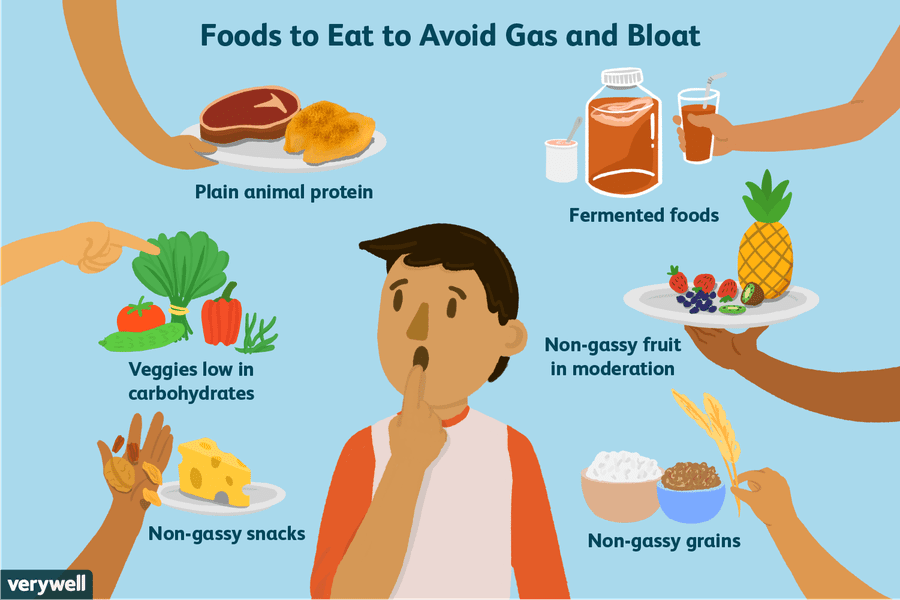
* - infant formula Option 3. ** - diluted with breast milk Up to 7 months, increase the volume of porridge and vegetable puree to 150 g and introduce fruit puree. I feeding
6 hours Breast milk or VHI* 200 ml II feeding
10 hours Dairy-free porridge**
Fruit puree 150 g
20 g III feeding
14 hours Vegetable puree
Meat puree Vegetable oil
Fruit juice 150 g
5 - 30 g
1 tsp
60 ml IV feeding
18 hours Fruit puree
Breast milk or VHI* 40 g
140 ml V feeding
22 hours Breast milk or VHI* 200 ml
** - diluted with breast milk or VHI 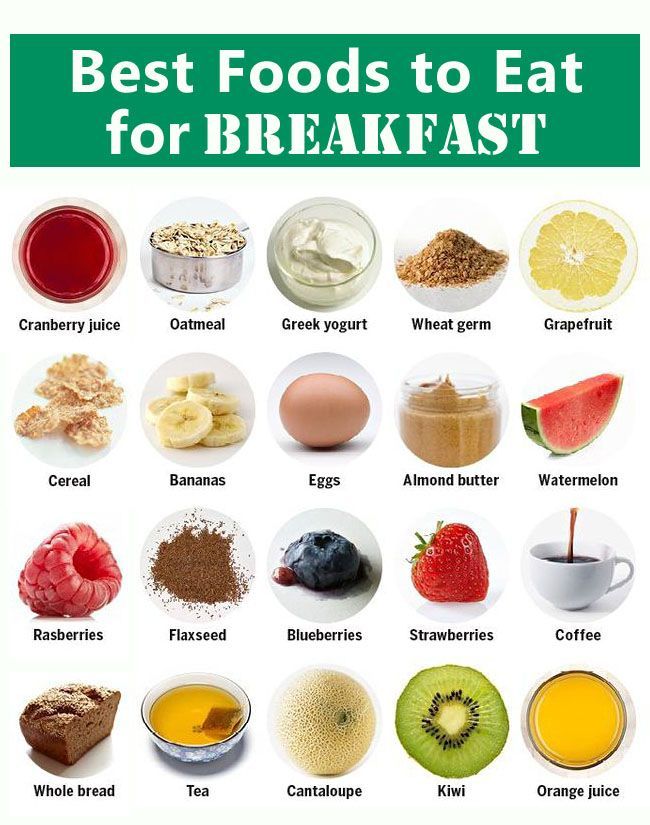 :
:
I feeding
6 hours Breast milk II feeding
10 hours Dairy-free porridge**
Breast milk supplement 100 g III feeding
14 hours Vegetable puree
Meat puree Vegetable oil
Breast milk supplement 100 g
5 - 30 g
1 tsp IV feeding
18 hours Breast milk V feeding
22 hours Breast milk 